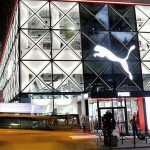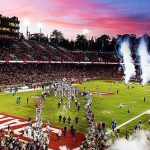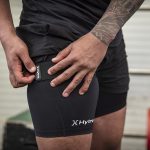Industry companies hit the road last week in hopes of drumming up some new investment dollars during a time of difficult trading conditions. The two big conferences for the active sports lifestyle market were the ICR Xchange Conference in Dana Point, CA and the Cowen & Co. Consumer Conference in New York.
Regarding consumer spending, Wiseman said what's really impacting VFC's business has been the erosion in consumer confidence.
“When it comes right down to it, this situation in the apparel space is much less about an inability to spend than it is about an unwillingness to spend,” said Wiseman. He noted that consumers are trading down across the board and “absolutely shifting” more to buying what they need rather than what they want.
“Thrift is reacquiring virtue,” said Wiseman. “That's not all a bad thing. And conspicuous consumption and flash are moving out of style a little bit.”
Nonetheless, he noted that “value absolutely does not mean lower price, necessarily . Some of our brands are getting terrific growth in products that they've added value to the product and increased the price.”
Regarding the Outdoor Coalition, Wiseman said the division, in 2008, for the first time matched in size its heritage Jeanswear business that includes Lee and Wrangler. Overall, the Outdoor Coalition has grown from 3% of its overall sales in 1999, when only Jansport was in the group, to about 36% of the business today.
“Now, we're going to invest in those three activities at different levels than we had originally assumed,” Wiseman said. “But we are not going to jump into a hole and wait this out. We're going to pick our spots to grow. We'll pick the brands and the markets, and the e-commerce and the stores to open. And it will not be as ambitious a plan as we had a year ago, but we will continue to move forward. And at the same time, we will continue to leverage our global cost structure and our global supply chain.”
At the same time, the company announced “aggressive” expense reductions as it lowered fourth quarter expectations a second time due to the stronger U.S. dollar and weaker consumer spending. VF officials projected fourth quarter earnings, excluding restructuring charges, to be down 7% to 11% on a 2% revenue drop, including a negative 2% impact from foreign currency translation.
Excluding this charge, VFC said fourth quarter earnings are expected to range between $1.30 and $1.35 per share, a decline of 7% to 11% from the $1.46 per share reported in the fourth quarter of 2007. On a reported basis, including the charge, fourth quarter earnings should be $1.00 to $1.05 per share.
For the full year 2008, revenues are expected to rise about 6%. Including the aforementioned 30 cents charge, earnings per share are expected to be about flat compared with 2007 levels. Excluding the charge, earnings per share would be up approximately 5% to 6%. In October, VF said it expected full-year revenue to grow 7% to 8% while earnings were forecast to increase 8% to 9% for the year.
For full-year 2009, VFC forecasted per-share earnings above the company's long-term growth target of 10% to 11%, excluding impacts from higher pension costs and the stronger dollar. Revenue is expected to be “down slightly.”
Deckers Outdoor re-affirmed guidance of 52% growth in sales and 40% EPS expansion and is on target to reach its goal of $1 billion in sales by 2012, said CFO Tom Hillebrandt during the ICR conference last week. The company also re-affirmed its previously issued guidance for 2008 calling for 52% sales growth. Looking towards the future, Deckers has started its retail expansion strategy with 10 stores in the U.S., four of which are flagship stores and six are outlet retail stores. The ten UGG stores in the U.S. include NY (2), Chicago, San Francisco and London (2). UGG plans to expand mens, childrens and international segments (U.K. 57%); $750 million in annual sales by 2012; convert distributors to subsidiaries.
The Deckers international business is about 14% of the business and all done through distribution, while over 10% of the companys business is done via e-commerce. DECK sees growing international business to 30% of total revenues by 2012. UGG has a joint venture partner in China. “The company does not have any debt; it's a strong cash flow generating business,” said Hillebrandt. Of the four shoe brands, he commented, “They are non-competing brands All four of them can sit in anyone's closet and not compete with each other. With that portfolio we think that we can get those brands up to $1 billion by the year 2012, broken down by $750 million from UGG, $140 million from Teva, $75 million from Simple, and $35 million from Tsubo.”
And Maintaining Liquidity For the Difficult Year Ahead…
Wolverine World Wide said the Merrell brand has sold nearly 14 million pairs in over 160 countries around the world and is expected to be the company's first $1 billion brand. Merrell apparel, which launched in the fall of 2007, “is now hitting its stride,” according to management. The sell-through in fall of 2008 has been “quite strong”, and the retailer acceptance of the spring '09 collection has been “quite strong as well.”
The company expects to report its ninth consecutive year of record revenue for 2008, and its eighth consecutive year of record earnings per share.
Wolverines outdoor brands, which include Merrell and Patagonia, contribute about 37% or $440 million of consolidated revenue. The Wolverine Footwear Group, which is Wolverine and Bates, accounts for 22% or about $260 million of revenues.
The Heritage brands group, consisting of Caterpillar, Harley-Davidson, and Sebago, is about 20% or $240 million of revenue. The Hush Puppies is an operating group unto itself that contributes about 14% or $170 million of revenue. Wolverine retail, as well as its smaller leather division, is 7% of consolidated revenue.
Over the longer-term, 1999 through 2007, EPS has grown at a compound rate of 14.7%, more than twice the rate of revenue growth. Gross margin has expanded over 700 basis points from 1999 through 2008 as it increasingly move towards more sourcing through third-party factories.
Wolverines public guidance at this point, which has not been updated since early October, is for EPS for the full year of $1.87 to $1.92 per share.
Wolverine is planning for a reduction of 450 positions, which is about 10% of its overall headcount. The charges to be recorded throughout the course of 2009 will be in the range of $31 million to $36 million. The annualized benefits, once all the initiatives are fully implemented, are about $17 million and $19 million on a go forward basis.
Cabela's management opened their presentation at ICR by touting the size of their business and the amount of consumers they can reach. Their 29 retail stores operating in 20 states and Canada produce $332 per square foot in sales. In addition to the retail footprint, management claimed the CAB catalog buinsess was 4x to 5x larger than its nearest competitor, while the companys online operations have 2x more visitors than the nearest competitor growing at a 26% CAGR over the past four years. Tapping both sides of the equation, Cabelas has grown its multichannel customer base at a 63% CAGR.
Moving forward, though, the company will shift its focus from the massive 150,000 square foot stores it had been opening to smaller doors of approximately 80,000 square feet. The first one we have opened was in Rapid City, South Dakota, an 80,000 square foot store this fall.
Responding to a question on the companys credit card program, CFO Ralph Castner, commented that “Not surprisingly, we have seen an increase in charge-offs We have seen an increase in both delinquencies and bad debts.”
Management also expects that the support it has received from local municipalities as a draw for new stores to open will being to lessen, especially as they begin opening the smaller sized new stores.
Lululemons balance sheet is a rarity in todays economic environment CEO Christine Day said in an investor conference earlier this week, noting that the company has no debt. “We have a very strong balance sheet And we finished the third quarter with over $53 million, which is one of our lowest quarters of the year in terms of cash flow,” she said. “We actually have strong cash flow. All four quarters were not reliant on a December seasonal holiday to really make our year.”
As for financials, CFO John Currie said that over the past three years, LULU has seen an almost 90% revenue growth.
“Part of that growth comes from new store openings,” said Currie. “And we've successfully extended our real estate rollout; as Christine said, we're on track for our 35 new stores this year. At the end of Q3, we were at 107 stores.”
Despite its positive expectations for 2009, the company still remains cautious in its guidance and reduced its earnings guidance by $40 million. “The balance was reflecting a slowdown in sales due to the economic downturn, so we changed our comp store guidance for the year from high-single-digits to high negative single-digits. And of course, EPS is impacted with our revised guidance down from 68 cents to 71 cents range down to 55 cents to 57 cents.”
More Insight, Warnings and Caution…
Volcom management reported that for the year-to-date through the end of the third quarter, net sales had grown 33% to $265 million. Sales in the U.S. accounted for about 69% of Volcoms business, with Europe about 23% and Electric is about 8%. Men's is about half of the companys business, Girls is about a third, and Boys, Eyewear and the other categories make up the remaining third. Management was happy to report to the room of investors that as of September 30th, the company had $73 million in cash on hand with nearly no debt. That cash on hand came after two acquisitions in the fiscal year, Electric Eyewear and a two-store surf chain in SoCal that accounted for $29 million. Inventory has grown from the year-ago level, but VLCM attributed some of the growth to the Electric acquisition. On a consolidated basis, turnover is about 7.6x per year for the first nine months.
Domestically, Volcom currently operates 10 domestic Volcom-branded retail doors as well as the two Laguna Surf & Skate stores the company acquired in 2008. Internationally, VLCM operates two stores in Europe and one in Japan, works with a licensee on eight retail outlets and has seven licensed international stores.
Under Armour Inc. reported that it expects fourth quarter net sales to range between $179 million and $180 million, up in the 2.5% to 3.0% range from year-ago sales of $174.8 million. Income from operations, however, is expected to decline between 15% to 22% to a range of $22 million to $24 million. Diluted earnings per share is expected to be in the range of 16 cents to 18 cents a share, down from 34 cents per share last year.
The company expects full year 2008 revenues in the range of $725 million to $726 million, up approximately 20% from year-ago revenues of $606.6 million. Full year 2008 income from operations are expected to be approximately $76 million to $78 million, down 10% to 12% from last years $86.3 million. Diluted earnings per share for 2008 will drop to between 76 cents and 78 cents from $1.05 last year. The company previously anticipated 2008 net revenues in the range of $750 million to $765 million and 2008 income from operations in the range of $97.5 million to $104.5 million. Inventory at year-end is expected to increase approximately 10% from year-end 2007.
Zumiez is looking to the second half of 2009 before it expects to see any respite from the tough macroeconomic conditions. CFO Trevor Lang noted that, “Through the first seven months of this fiscal year, our comps were down about 1% and our product margins were down slightly. But as we moved into the back part of the year after back to school, our comps started declining more meaningfully.” He noted that the latter part of the year saw comps down in the high-single-digits to mid-teens, which produced a “pretty marked change in our product margin, especially in our apparel business which is about half of what we sell.”
He did see positives coming in H209, with the second half of the year typically providing approximately 80% of Zumiez earnings for the year. E-commerce has been a bright spot for ZUMZ, up approximately 60% for the first nine months of the this year.















